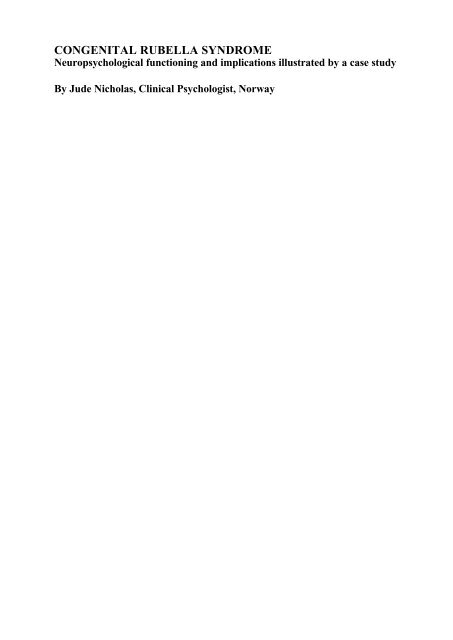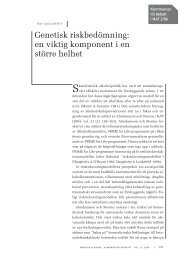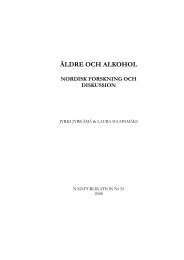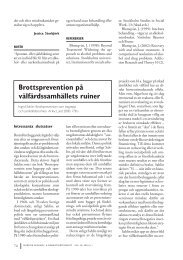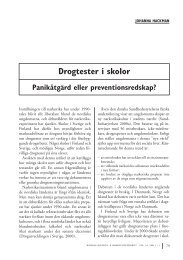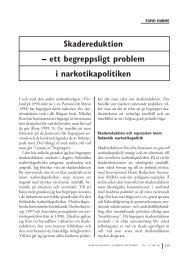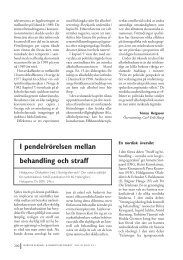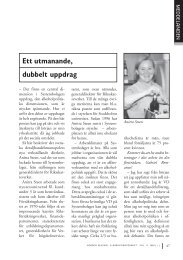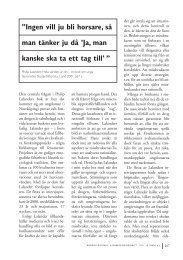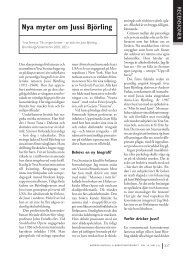CONGENITAL RUBELLA SYNDROME
CONGENITAL RUBELLA SYNDROME
CONGENITAL RUBELLA SYNDROME
You also want an ePaper? Increase the reach of your titles
YUMPU automatically turns print PDFs into web optimized ePapers that Google loves.
<strong>CONGENITAL</strong> <strong>RUBELLA</strong> <strong>SYNDROME</strong><br />
Neuropsychological functioning and implications illustrated by a case study<br />
By Jude Nicholas, Clinical Psychologist, Norway
<strong>CONGENITAL</strong> <strong>RUBELLA</strong> <strong>SYNDROME</strong><br />
Neuropsychological functioning and implications illustrated by a case study<br />
By Jude Nicholas, Clinical Psychologist, Norway<br />
Preface<br />
My work with persons with congenital rubella syndrome (CRS) was presented at a<br />
conference on adult persons with CRS at the Nordic Staff Training Centre for<br />
Deafblind Services (NUD) in May 1999. After my presentation I was asked by the<br />
director of NUD, Anny Koppen, to write an article describing my work, which<br />
could be included in the Nordic Directory for Staff in Deafblind Services as one of<br />
its publications.<br />
I would like to thank gratefully Professor Hallgrim Kløve at the University of<br />
Bergen for his professionally inspiring guidance and support for my work.<br />
I also thank my colleagues at the Regional Centre for Deafblind Persons in Bergen<br />
for going through my manuscript. In particular I have appreciated Jan Ottar<br />
Hermansen's and Harald Haldorsen's enthusiasm.<br />
Many thanks to Nordic Staff Training Centre for Deafblind Services, which made<br />
this publication possible. Especially thanks to Elin Østli for good co-operation on<br />
this project.<br />
Last, but not least I would like to thank Stan Munroe, The Canadian Rubella<br />
Association and Norman Brown, Birmingham University and Sense for their very<br />
good suggestions regarding this English translation of the Norwegian original.<br />
Vestlandet Resource Centre, July 2000<br />
2<br />
Jude Nicholas
The structural variation of the higher mental functions at<br />
different stages of ontogenetic development means that their<br />
cortical organization likewise does not remain unchanged<br />
and that at different stages of development they are carried<br />
out by different constellations of cortical zone... (thus)... the<br />
character of the cortical intercentral relationships does not<br />
remain the same at different stages of development of a<br />
function and.… the effects of a lesion of a particular part of<br />
the brain will differ at different stages of functional<br />
development.<br />
(Luria, 1980, p. 34-35)<br />
<strong>CONGENITAL</strong> <strong>RUBELLA</strong> <strong>SYNDROME</strong><br />
Neuropsychological functioning and implications illustrated by a case study<br />
Introduction<br />
Rubella is also known as German Measles. When the rubella virus infects children<br />
or adults normally a slight and self limiting illness develops, with rash like red<br />
spots, swollen glands, low-grade fever, running eyes, sore throat and aching joints.<br />
In some cases the symptoms of infection are too mild to notice.<br />
The disease German Measles was first described more than 200 years ago. Only in<br />
1941, however, the high incidence between rubella infection during early<br />
pregnancy and congenital cataracts was observed by the Australian<br />
ophthalmologist Sir Norman Gregg. Gregg also reported that low birth-weight,<br />
congenital heart defects, deafness and nutrition problems were over-represented<br />
among children born with German Measles (Givens et al, 1993). It was not until<br />
1962 that one was able to isolate the rubella virus, and in 1966 it was announced<br />
that vaccination against the disease had been developed. Today many countries<br />
have implemented a routine immunisation programme for all infants at the age of<br />
about 15 months, in some countries followed by revaccination of both sexes before<br />
puberty.<br />
The 1960s' pandemic is believed to have affected 12.5 million individuals worldwide<br />
(Munroe, 1999). Despite the fact that today, congenital rubella is a low<br />
frequency aetiology for hearing impairments and deafblindness in our part of the<br />
world, there are many congenitally deaf and deafblind young and adult persons<br />
whose sensory impairments are caused by rubella. Just a few decades ago maternal<br />
rubella was an important cause of congenital deafblindness.<br />
Rubella virus is generally acquired by airborne distribution, and enters the<br />
maternal respiratory tract (McCracken, 1963). The risk of congenital impairments<br />
due to rubella is relative to the age of the foetus at the time of infection. The risk of<br />
impairments are estimated to be 40 - 60% with infections during the first eight<br />
3
weeks, 30 - 35% during the third month of pregnancy and around 10% with<br />
infections during the fourth month (Dudgeon, 1967). Van Dijk (1991) has shown<br />
that children with cataracts in both eyes were infected during the first two months<br />
of pregnancy, when the lens of the eye is developing and rapidly changing, and<br />
thus vulnerable when exposed to the effects of the virus. After the tenth week of<br />
pregnancy, when the lenses are fully developed, they are probably sufficiently<br />
protected against the damaging effects of the rubella virus. Damages from<br />
infections later than the tenth week of pregnancy are therefore likely to be<br />
restricted to the inner ear and can entail deafness. The Organ of Corti is the part of<br />
the inner ear, which links the ear and the brain, and is often the structure which is<br />
damaged by rubella.<br />
Both early and late manifestations have to be considered in connection with<br />
congenital rubella syndrome or CRS for short.<br />
Early manifestations of CRS may be a combination of hearing impairment,<br />
congenital cardiac problems (ventricular septum defect), visual impairments<br />
(cataracts) and neurological problems of various types (microcephaly, cerebral<br />
palsy, hypotonia, poor balance, dysco-ordination and mental retardation). The<br />
embryo genetic timetable indicates that the most rapid development of the heart<br />
muscle occurs at much the same time as the inner ear and lenses are developing.<br />
Therefore damage to the ears and eyes is often accompanied by a variety of heart<br />
defects (van Dijk, 1982). While the disease is in its outbreak, one could find<br />
damaging conditions like hypoxia (reduced provision of oxygen) and acidosis<br />
(high acid levels in the body) (Rorke, 1973). Damage or disability not related to<br />
rubella is always possible, even if it is unlikely.<br />
Autistic-like behaviour is often seen among children with congenital rubella<br />
syndrome (Chess, 1977). According to van Dijk (1991) there is no biologically<br />
conditioned link between rubella and autism. The ritualistic behaviours<br />
demonstrated by children with CRS are not manifestations of autism, but rather a<br />
consequence of sensory deprivation (van Dijk, 1982).<br />
Children with CRS may later in life develop new symptoms (referred to as delayed<br />
or late manifestations). These manifestations may have their onset during early<br />
teens, late teens, young adulthood or later (O'Dea and Mayhall, 1988). The<br />
symptoms include change in hearing ability, visual problems (acquired glaucoma,<br />
detached retina ) diabetes (insulin dependent Diabetes Mellitus), thyroid conditions<br />
(usually hypothyroidism), gastrointestinal difficulties, vascular problems<br />
(hypertension), psychosocial problems (withdrawal, reduced frustration threshold<br />
and depressed mood), epilepsy, behavioural problems (impulsive behaviour,<br />
concentration problems and attention deficiencies). The causes of these late<br />
manifestations are unclear. Many think that these new symptoms are due to a<br />
persistent infection of the rubella virus in the affected organ, or that the old<br />
4
infection sets up an autoimmune response. It is important to note that not all<br />
persons with CRS will develop such late manifestations.<br />
The central nervous system is affected in several ways. The presence of the rubella<br />
virus in the central nervous system, the auditory and visual nerves included, may<br />
lead to infectious conditions like leptomeningitis, encephalitis, vasculitis and may<br />
reduce cell division in the embryo. Viral infections like rubella may disturb the<br />
formation and migration of nerve cells and entail reduced cortical maturation<br />
(Smith, 1996). In addition the virus may lead to overall retardation in the formation<br />
of myelinated fibres (Rorke & Spiro, 1967).<br />
Myelin, a fatty substance that wraps around some nerve fibres, lets nerves transmit<br />
signals faster and more efficiently. Although, myelination occurs in certain neural<br />
regions prenatally (e.g. certain pathways of the spinal cord), the majority of the<br />
fibrous tracts of the central nervous system are not fully myelinated until the first<br />
few postnatal years. Even then, the myelination process may continue until puberty<br />
or adulthood (Altman, 1967).<br />
Computed tomography (CT) findings correlate with the degree of developmental<br />
retardation otherwise observed in children with CRS (Ishikawa et al., 1982).<br />
According to van Dijk (1997) prenatal infections such as rubella and<br />
cytomegalovirus (CMV) may damage the central nervous system to such a degree<br />
that the orienting response and the speed of habituation may be affected. Research<br />
on the speed of habituation shows that biological disorders can influence cognitive<br />
potential in a negative way. It is assumed, that the ability to habituate and how<br />
quickly a person habituates are expressions of the maturation of the central nervous<br />
system (Rovee-Collier, 1987).<br />
Orienting response and habituation<br />
Children normally learn to interpret, understand and adapt to their environment<br />
through meaningful and integral interaction with the environment. This adaptation<br />
is conditioned by the brain's ability to perceive and process the information coming<br />
from the senses (auditory, visual and tactile). Children are exposed to a continuous<br />
stream of experiences and have to habituate or cease reacting to some of them in<br />
order to be able to direct the attention to another specific stimulus. This is a natural<br />
part of children's everyday behaviour. In other words, children choose which<br />
stimuli in the environment they want to pay attention to. This is the simplest of all<br />
forms of learning.<br />
New stimulation most often makes the individual orient towards the stimulus and<br />
prepare for action. This is referred to as the orienting response or orienting reflex<br />
(e.g. we direct our attention towards the source of an unknown noise). The<br />
orienting response has been interpreted as reflecting the anticipatory process<br />
5
during which the future consequences of the stimulus are being evaluated. The<br />
orienting response thus makes the organism ready for organised behaviour (van<br />
Dijk, 1997). The orientating response may be easily observed (e.g. focusing of the<br />
eyes/turning of head) or it can provoke changes in the autonomous nervous system<br />
(e.g. increase of muscle tone/ changes in pulse rate or skin responses).<br />
When an organism is repeatedly presented with a stimulus that is not consistently<br />
associated with any particular consequence, the organism may cease to respond to<br />
the stimulus. This process is known as habituation. Habituation is generally<br />
defined as a decrement in response to an initially novel stimulus when it is given<br />
repeatedly. In other words, the novelty of the stimulation diminishes.<br />
Habituation is characterised as the filtering of irrelevant sensory impressions. This<br />
means that habituation serves to eliminate inappropriate responses to stimuli that<br />
carry no serious consequences, and is therefore quite adaptive. Habituation holds<br />
for many everyday events. We have become so accustomed to the ticking of a<br />
clock that we are utterly unaware of it until it finally stops. By the same token,<br />
people living close to a waterfall will get used to its roar after some time, and not<br />
even notice it.<br />
To begin with, we can say that habituation is a reduction of the orienting response<br />
to a given stimulus. However, we have to distinguish habituation from adaptation<br />
and fatigue/exhaustion. Adaptation is often a lack of response due to processes<br />
limited to sensory receptors. On the contrary, fatigue/exhaustion is a lack of<br />
response due to processes limited to the muscle, neuromuscular junction or other<br />
effectuation organs. It is only when the lack of response is caused by a process<br />
within the central nervous system, i.e. changes in interneuron activity, that we use<br />
the term habituation.<br />
We can distinguish habituation from adaptation and fatigue by looking at the<br />
responses following new stimulation. Presentation of another (usually extra strong)<br />
stimulus causes restoration of the response. This is called dishabituation. If, again,<br />
the first stimulus is presented, i.e. the stimulus to which the person was habituated,<br />
the person will again show orienting response. In other words, the person shows a<br />
subsequent recovery of attention when a new stimulus is presented.<br />
It is important to note that the orienting responses and their habituations are the<br />
constituents of a very important self-regulating system. Self-regulation is the<br />
ability to regulate one’s own behaviour, which requires the subject to shift course<br />
of thought and action according to the demands of the situation.<br />
Impaired habituation can reduce the efficiency of and slow cognitive processing,<br />
such as that caused by rubella infection. Habituation is a predictor of cognitive<br />
development and an essential element in attentional cognitive processing. For<br />
example, habituation allows the nervous system to prepare for a change in focus of<br />
6
attention to the next important stimulus. When our attention is evoked by a new<br />
stimulus the activating system is affected.<br />
Habituation and arousal<br />
The level of arousal or the physiological activation of the nervous system are<br />
related to behaviour and are described as a correlate to or consequence of action.<br />
Habituation is closely related to the concept of arousal, which is an important<br />
dimension within neuropsychology. In general, one could relate the concept of<br />
arousal to an “intensity dimension” of behaviour and in a neurological context it<br />
may represent the degree of cortical activation. Arousal may reflect the degree of<br />
activity in a central activating system, which will be reviewed later. Thus the<br />
concept of arousal could be candidate to a fundamental explanatory principle of<br />
human behaviour. Luria (1973) maintained that the general arousal level is<br />
dependent on several factors, such as sensory input, metabolic processes, and<br />
cortical functioning.<br />
Figure 1<br />
Behavioural Arousal and Performance<br />
Different levels of arousal can be observed in terms of behavioural states. It is<br />
assumed that the degree of arousal varies along a dimension from deep sleep or<br />
pathological coma on one hand to a hyperaroused state of emotional and cognitive<br />
chaos or panic on the other hand. An organism's normal arousal level will be found<br />
7
somewhere between these extremes. Malmo (1959) has demonstrated that the<br />
relationship between performance and arousal level can be described as an inverse<br />
curve, where both very low and very high levels of arousal result in an impairment<br />
of functioning and performance (see fig. 1). This means that at low levels of<br />
arousal there is poor performance, and when the level of arousal increases,<br />
performance will increase, until a certain limit. If the level of arousal exceeds this<br />
limit, performance will drop again. Both very high and very low arousal levels<br />
interfere with functions such as attention, concentration, cognition and emotional<br />
control.<br />
The u-curved relationship between performance and arousal can be explained by<br />
the information processing theory. The concept of arousal may indeed represent a<br />
fundamental principle governing the interaction of the organism with its<br />
environment and influencing the manner in which information about the<br />
environment is stored and retrieved. A prerequisite for processing cognitive and<br />
emotional information and for responding adequately is that the person is in a<br />
favourable state of arousal (Grøttland, Jacobsen and Andreassen, 1998). Thus, in<br />
order to function normally and adequately it is necessary that the individual has an<br />
optimal level of arousal.<br />
Individuals fluctuate about particular optima and their behaviour is designed to<br />
maintain a desirable equilibrium. Individuals vary in the equilibrium state, which<br />
they find pleasurable or tolerable, and in the clinical case the optimal state may<br />
preclude normal functioning. Stress responses could also be explained within the<br />
framework of arousal and activation theory (Eriksen, 1998). The stress response<br />
occurs whenever there is discrepancy between what the organism is expecting, and<br />
what really happens.<br />
The physiological basis for variation in behavioural states is present already at<br />
birth. Environmental factors and the neurological maturation of the cortex<br />
contribute to stabilise and regulate these states (Grøttland et al., 1998). Field<br />
(1981) has presented a model for infants' attention and positive affect during early<br />
interactions, based on the theory of optimum level of arousal. Atypical children,<br />
e.g. prenatal cocaine- exposed children or rubella children, may show distorted<br />
patterns of arousal, and this may negatively affect these children's ability to direct<br />
and sustain attention. For example, Mayes et al. (1993) have shown that cocaineexposed<br />
newborns obtained significantly lower scores than control children on the<br />
habituation cluster on a neonatal behavioural scale, which measured the regulation<br />
of attention in neonates. This means that it may be more challenging to regulate<br />
these children's attention and affective expressions in situations of interaction<br />
(Smith and Ulvund, 1991).<br />
The measures of state of arousal have been many. Different neurophysiological<br />
and psychophysiological methods could be used to measure the level of arousal<br />
and habituation (e.g. EEG, Event Related Potentials and heart rate responses).<br />
8
Presentation of visual stimuli and pupillary responses have also been used to<br />
measure arousal and habituation (Kim, Beversdorf & Heilman, 2000).<br />
Arousal level and habituation is normally measured by registering the skin<br />
conductance reaction to sound. In the test situation the person is exposed to<br />
auditory stimulation with varying intervals. The human skin has properties of<br />
electrical conductance, as well as electrical resistance. The measurement of the<br />
electro-physiological activity of the skin (Skin Conductance, Galvanic Skin<br />
Resistance, and Skin Potentials) reflects activity in the autonomous nervous<br />
system. The autonomic sympathetic activity is influenced by the arousal or<br />
activating system. Skin conductance tests are applied to assess the ability of the<br />
brain stem to perform normal reaction. For example, studies by Satterfield &<br />
Dawson (1971) and by Kløve & Hole (1979) found that hyperactive children had a<br />
lower skin conductance level and a more rapid habituation rate to auditory stimuli<br />
than control children, thus indicating a state of central hypoarousal in hyperactive<br />
children.<br />
The activating system of the brain<br />
When we refer to activation or arousal, we are talking about the generalised,<br />
undifferentiated, central activating system response which has two important<br />
dimensions: the general activation of the cortex and the general activation of the<br />
nervous system, notably the sympathetic part.<br />
This activating system of the brain consists of the reticular formation and certain<br />
other subcortical structures (thalamus among others). The reticular formation is<br />
localised in the brain stem. The reticular activating system plays a crucial role not<br />
only in activating the cortex but also for behavioural arousal. Independently of the<br />
source of stimulation this system produces excitatory effects on the cortex, and<br />
through this mechanism the organism can be awakened or aroused by various<br />
stimuli. Moruzzi and Magoun (1949) found that the stimulation of the reticular<br />
formation led to cessation of cortical electrical activity characteristic of drowsiness<br />
and sleep, and a switch to electrical activity associated with wakefulness.<br />
According to Luria (1973) the role of the activating system is to maintain an<br />
optimal level of cortical tone which is essential for the organised course of mental<br />
activity.<br />
The reticular formation consists of diffuse collections of cells and fibres in the<br />
central core of the brain stem. It stretches from the spinal cord and up to the<br />
thalamus and has connections to several parts of the brain (Brodal, 1990). Fibres<br />
from each of the sensory systems (with the exception of the olfactory system) send<br />
off branches to the reticular formation as they pass through the brain stem on their<br />
way to the cortex. The reticular formation is sometimes called a non-specific<br />
9
sensory system, because in some experiments it has been possible to stimulate the<br />
structure alone and produce the cortical and behavioural effects of arousal.<br />
The reticular activating system has effects on all the functions in the central<br />
nervous system (see figure 2). Particular attention has been drawn to the<br />
importance of the reticular activating system in relation to its excitatory and<br />
inhibiting functions, or in other ways regulating the activities of the central<br />
nervous system.<br />
Figure 2<br />
The Reticular Activating System (RAS) showing its inputs from sensory tracts in the brainstem and its<br />
projections to the hypothalamus, and the thalamus, which in turn project to the cerebral cortex.<br />
We can imagine that a certain "activity tone" in the reticular formation is<br />
maintained by impulses from all parts of the nervous system, and that the impulses<br />
vary in types and in quantity. It has been shown that the activity in the reticular<br />
formation is necessary for the conscious perception of, and adequate reactions to,<br />
specific sensory stimulation. The evidence is overwhelming that the reticular<br />
formation is a necessary prerequisite for activation. This relationship is frequently<br />
distorted in the presence of subcortical-division dysfunctions. Viral infections,<br />
such as rubella can affect the neural integration of the reticular activating system.<br />
Partial interruptions in the reticular activating system may produce selective<br />
cognitive deficits. Dysfunctions of the reticular activating system may be<br />
associated with deterioration or disorganisation of particular cognitive functions,<br />
such as disruptions of attention and concentration, memory disturbances, and it<br />
may also affect emotional adaptability (Kløve, 1995).<br />
Reticulo-frontal connections<br />
10
The brainstem reticular formation responsible for orienting, activation and arousal<br />
seems to be closely related to the cortex, mainly to its frontal parts (prefrontal<br />
cortex). The intimacy between the reticular system and the frontal lobes (reticulofrontal<br />
connections) has been shown both neuroanatomically (Kievit and Kuypers,<br />
1975; Nauta, 1971) and functionally (Damasio, 1985; Luria, 1980). The bidirectional<br />
nature of the reticulo-frontal interactions has also been demonstrated<br />
electrophysiologically (Homskaya, 1970). Neuroanatomically it has been shown<br />
that the mesencephalon (midbrain: ventral portion) is the main point of origin of<br />
reticular projections into the prefrontal cortex (Nauta & Domesick, 1981). Watson,<br />
Valenstein & Helman (1981) have stressed the importance of cortico-midbrain<br />
reticular loops for activation and arousal.<br />
Because of the intimate relationship between the reticular system and the prefrontal<br />
cortex, it is virtually predictable that the damage to reticulo-frontal projections will<br />
produce a damage, which looks like a frontal lobe damage. Damages in the frontal<br />
lobe are clinically observed as inability to initiate actions, inability to switch from<br />
one activity to another (cognitive rigidity and perseveration), inability to plan and<br />
structure behaviour, poor impulse control and impairment in judgement and insight<br />
(Schanke, 1992). Although the frontal lobes are vulnerable in head trauma, these<br />
symptoms can be found in the absence of obvious structural lesions within the<br />
frontal lobes (Stuss & Benson, 1987). Lesions outside the frontal lobe can cause<br />
the neuropsychological picture of the frontal lobe damage per se, which interferes<br />
with reticulo-frontal projections. It is proposed that any brain dysfunction affecting<br />
the reticulo-frontal interactions constitute a "reticulo-frontal disconnection<br />
syndrome" (Goldberg, Bilder, Hughes, Antin & Mattis, 1989).<br />
Neuropsychological aspects of CRS<br />
Few studies have dealt with neuropsychological deficits in persons with congenital<br />
rubella syndrome. Individuals with CRS are found to have a high incidence of<br />
certain behaviours (O'Donnell, 1995). Vernon (1967) has reported that children<br />
deaf from rubella have more psychological difficulties than children who are deaf<br />
from other causes.<br />
Individuals with CRS have been noted to have certain behavioural disturbances<br />
such as attentional difficulties, impulsivity and low frustration tolerance (O'Dea<br />
and Mayhall, 1988). A Canadian survey of late emerging manifestations related to<br />
congenital rubella reported aggression, tantrums, self-stimulation, irritability,<br />
ritualistic compulsive behaviour, and decreased attention span, as the most<br />
commonly observed behavioural disturbances (Munroe, 1999).<br />
In a longitudinal study of children with congenital rubella, where deaf (severe or<br />
profound hearing loss) and deaf multihandicapped individuals (handicaps included<br />
visual defects, neuromotor difficulties, and autism) were compared to normal<br />
11
controls (rubella children without any physical defect), Chess and Fernandez<br />
(1980) found that both the group of deaf persons and the group of deaf<br />
multihandicapped persons showed a higher incidence of impulsivity than the<br />
normal control group. Impulsivity was defined to include sudden unpredictable<br />
acts, which are triggered by some minor incident or no discernible stimulus.<br />
Furthermore, they found that hyperactivity and rigidity were present to a greater<br />
degree in the deaf multihandicapped group than in the other two groups. These<br />
behavioural characteristics may be a consequence of sensory impairment, but<br />
central nervous system disturbances may be a contributory factor. This is<br />
especially true when neurological and other disturbances coexist, as is frequently<br />
the case in persons with congenital rubella.<br />
Certain neuropsychological deficits are prominently associated with CRS. These<br />
are difficulty in shifting from one task to another, sudden shifts in mood or<br />
overreaction to minor stimuli, high distractibility and perseveration (Desmond et<br />
al., 1978). Perseveration refers specifically to repetitive prolongation or<br />
continuation of an act or activity sequence, or repetition of the same or similar<br />
response to various questions, tasks, or situations. In the latter sense it may be<br />
described as stereotypy of behaviour (Lezak, 1995). The person may repeatedly<br />
attempt to fit a puzzle piece in the same space and in spite of continued failure, try<br />
again and again without shifting his or her approach. There may be perseveration<br />
of rituals - habitual and often complicated actions that serve no apparent purpose,<br />
which if not interfered with may continue for a lengthy period of time. The<br />
tendency to perseveration may express a general lack of flexibility both in thought<br />
and in action. This kind of behavioural disturbances observed in individuals with<br />
CRS is considered to be associated with frontal lobe damage (Gardner, 1994).<br />
Are the behavioural late manifestations of CRS a result of a reticulo-frontal<br />
disconnection syndrome?<br />
Prefrontal cortex controls the hierarchic organisation of complex activities. The<br />
human prefrontal cortex attends, integrates, formulates, monitors, modifies, judges<br />
and executes all nervous system activities (Stuss & Benson, 1987). Both clinical<br />
and empirical studies demonstrate that the prefrontal cortical regions of the brain<br />
(i.e. the frontal lobe) are responsible for the so-called executive functions. In much<br />
of the literature concerning the executive functions, frontal lobe damage is<br />
implicated (Lezak, 1995). Executive functions comprise those abilities that enable<br />
individuals to maintain an appropriate problem-solving set for attaining future<br />
goals (goal-directed behaviour). These functions include strategic planning,<br />
impulse control, organised search, and flexibility of thought and action. According<br />
to Barkley (1997) the executive functions are responsible for regulating behaviour<br />
according to the outcome of its action (self-regulation). Many behavioural<br />
problems arise from impaired executive functions such as difficulties in<br />
suppressing response tendencies, poor impulse control, impaired judgement and<br />
12
perseveration. For instance, persons with impaired executive functions often ignore<br />
environmental cues so that their actions are out of context with situational<br />
demands. Baddeley and Wilson (1988) strikingly characterise frontal lobe failure<br />
as the "dysexecutive syndrome". However, the presence of a massive, focal<br />
prefrontal damage, while sufficient, is not necessary to produce the "dysexecutive<br />
syndrome". Perseverations can be elicited in cases with no evidence of focal<br />
frontal lesions, such as patients with diffuse encephalopathy secondary to viral<br />
infection (Goldberg & Bilder, 1987).<br />
The executive deficits observed in individuals with CRS may not be caused by<br />
lesions within the frontal lobe per se, but may be caused by developmental<br />
dysfunctions in reticulo-frontal projections. The late manifestations may then be<br />
explained by the fact that a virus infection has affected the central nervous system<br />
during its foetal development, but the lesion has no physiological or psychological<br />
effect until teen or adult age. The explanation to this is that those structures or<br />
neural connections, which are damaged during foetal development, are structures<br />
or neural connections, which mature or myelinate slowly and are not fully<br />
developed until relatively high age.<br />
Different areas of the brain are at different developmental stages at any given time.<br />
So while an injury to a fully developed brain will immediately become functionally<br />
manifest, it may remain silent and only slowly emerge from an area, which is<br />
structurally and functionally immature. Thus, early left hemisphere damage may<br />
lead to some initial speech difficulties in, say, a six-year-old, and may eventually<br />
resolve. However, problems with executive skills and higher level verbal reasoning<br />
may not emerge until the teens, although arising from the same injury. In a clinical<br />
study of school-aged children age-related changes in executive function<br />
performance were found, with increasing age associated with improved<br />
performance. In other words, there was a linear relationship between age and<br />
performance (Weyandt & Willis, 1994)<br />
We propose that the neuropsychological picture of the frontal lobe damage, which<br />
is seen in individuals with CRS is caused by lesions outside the frontal lobe per se,<br />
interfering with reticulo-frontal connections. This is due to the viral infection and<br />
may therefore represent a neurodevelopmental reticulo-frontal disconnection<br />
syndrome. The neuropsychological problems caused by this will not become<br />
distinct until many years later.<br />
Case report<br />
Clinical neuropsychological assessment involves the evaluation of human brainbehaviour<br />
relationships by means of standard testing methods. A full<br />
13
neuropsychological assessment yields a profile of abilities, which can be of great<br />
assistance in determining probable neurological causes of deterioration.<br />
R.J., a 16-year old girl, is hearing impaired and she uses sign language. She has<br />
been living in a school residence for the past years. The staff had noted that R.J.<br />
demonstrated behaviours such as tantrums, lessened frustration tolerance,<br />
impulsivity and social withdrawal. Even in situations when she was looking<br />
forward to participate in activities with others, she would withdraw and not<br />
participate. Judging social situations was also a problem for her. The staff had<br />
observed that she was incapable of perceiving performance errors, had difficulties<br />
in appreciating the impact she made on others, and had problems to size up a social<br />
situation appropriately. It seemed that she was unable to profit from experience,<br />
and could only make poor if any use of feedback and reality testing. R.J. was<br />
described as incapable of planning and sustaining goal-directed behaviour. At<br />
school, R.J. had problems with attention and concentration. She was referred for a<br />
clinical neuropsychological examination.<br />
R.J.'s mother had suffered from German Measles during her early pregnancy, but<br />
had a normal delivery after a pregnancy of normal length (birth weight was 2840<br />
grams). As an infant the patient had shown several typical manifestations of<br />
congenital rubella syndrome; hearing impairment, congenital heart defect<br />
(ventricular septum defect), hypotony, delayed motor development as well as<br />
oesophageal and gastro-intestinal disorders.<br />
Assessment: R.J. was subjected to an extensive neuropsychological examination,<br />
which included an intelligence test (Wechsler intelligence scale) and a<br />
neuropsychological test battery (Halstead-Reitan neuropsychological test battery).<br />
Furthermore she went through a personality assessment (PIC), and the<br />
psychophysiological arousal level was measured by a skin conductance test.<br />
The results of the intelligence tests were analysed on the basis of standardised<br />
norms developed especially for hearing impaired children (Andersen & Sisco,<br />
1976) and her full-scale score was below the average range for her age group.<br />
Further investigation showed that she performed averagely on subtests, which<br />
measured perceptual organisation (object assembly), visual recognition and<br />
identification (picture completion). However, she performed below average on<br />
subtests which revealed non-verbal conceptualisation, visuospatial understanding<br />
(block design) and psychomotor speed, visuomotor coordination (digit symbol).<br />
Digit symbol has been found to be the subtest most sensitive to cerebral<br />
impairment (Doehring, Reitan, & Kløve, 1961; Reitan & Wolfson, 1993). On the<br />
subtest which measured sequential thinking, the ability to see relationships<br />
between events, establish priorities and order activities chronologically (picture<br />
arrangement), R.J. performed far below average. This subtest has been interpreted<br />
as an indicator of understanding or competence in social situations.<br />
14
Her performance on a test of non-verbal abstraction and reasoning (Raven) was<br />
below the average. She also performed below average on a test, which measured<br />
visuospatial attention and concentration (Knox).<br />
Neuropsychological assessment revealed reduction in general cognitive ability, and<br />
evidence of difficulty with non-verbal abstraction and concept formation (Category<br />
Test). The Category Test requires organised memory, and is probably a meaningful<br />
indication of memory in practical, complex, everyday situations, especially<br />
considering that memory, in a meaningful behavioural context, necessarily depends<br />
on relating one aspect of the total situation to another (Reitan & Wolfson, 1993).<br />
She showed slowed performance on a tactile-motor-spatial task (Tactual<br />
Performance Test), with a low memory score (number of remembered shapes), and<br />
a low location score (number of properly localised shapes). Her performance on<br />
tests of simple and complex sequential functions and conceptual tracking were also<br />
below average (Trail Making Test, Part A & B). The Trail making Test is highly<br />
vulnerable to the effects of brain injury. It is therefore not surprising that the Trail<br />
Making Test is one of the best measures of general brain functions (Reitan, 1958).<br />
On a test requiring executive functions like strategic planning, the ability to<br />
maintain an appropriate problem-solving set, and the ability to change cognitive<br />
sets (Wisconsin Card Sorting Test), her performance was defective and she had<br />
many perseverative errors. This test has a reputation of measuring frontal lobe<br />
dysfunction (Rezai et al., 1993).<br />
The results for the tests of motor and sensory functions were normal, and they did<br />
not show any sign of laterality. Her autonomic reactivity was evaluated (SCL) and<br />
she showed a low skin conductance level and no skin conductance responses.<br />
Her personality assessment indicated withdrawal from social contact, lack of<br />
success in social activities, limited social skills, obsessive behaviours and<br />
brooding. This may confirm the problems R.J. faces in every day life such as<br />
understanding social situations and being tactful in interpersonal communication.<br />
Conclusion: The assessment showed that her strengths include the ability to<br />
process meaningful visual stimuli, the ability to organise new codes and categories<br />
of visuomotor character.<br />
The neuropsychological test profile (the hearing impairment taken into<br />
consideration) reflected moderate impairment of higher cortical functions, although<br />
certain abilities were quite well maintained. The problems that were identified as a<br />
result of this battery of tests (personality assessment included) were related to<br />
sustained attention, concentration, memory, psychomotor speed, executive deficits,<br />
interpersonal interactions and emotional adaptability.<br />
15
R.J.'s autonomic reactivity and orienting responses were absent, indicative of an<br />
activation deficit, which would be consistent with her problems with attention and<br />
concentration. It is also of importance that she had executive deficits, such as<br />
perseveration. It has been emphasised before about the role of reticular interactions<br />
with the prefrontal cortex in executive control. It is therefore possible that reticulofrontal<br />
disconnections specifically play a role in producing neuropsychological<br />
deficits and behavioural manifestations in individuals with CRS.<br />
Intervention/ Rehabilitation: According to Duncan (1986), much of the<br />
disorganised behaviour seen with patients with frontal systems dysfunction (i.e.<br />
dysfunction in the frontal cortex or its interconnections) can be attributed to<br />
deficits in maintaining intentions in goal-directed behaviour (goal management<br />
deficits). An important aspect of goal management is the selection of new actions<br />
when previously selected actions fail to achieve the goal. For most people with<br />
goal management deficits which affect their organisation of everyday behaviour, a<br />
viable method for rehabilitating executive functions is necessary (Levine et al.,<br />
2000).<br />
R.J. demonstrated neuropsychological deficits on tasks of attention, executive<br />
functioning, and memory deficits, which corresponded to her impaired selfregulation<br />
in managing demands of certain everyday situations. In particular, the<br />
staff was worried about her problems in judging social situations and in<br />
interpersonal communication. Applications of strategies which emphasise goal<br />
management training, should be considered (for a detailed description on goal<br />
management training, see Levine et al., 2000). The important principles one has to<br />
consider in the structuring of educational strategies are: Positive learning<br />
experience of routines, repetition, anticipation and real-life experiences. This kind<br />
of structuring provides predictability, and unexpected and more or less<br />
overwhelming events are likely to be avoided (van Dijk, 1997). At this level,<br />
emphasis is on increasing knowledge and skills.<br />
Her learning potentials/strengths are present and are most obvious in the area of<br />
sign language. She should be encouraged to face greater challenges in sign<br />
language communication. Her concentration problems must also be considered.<br />
She could follow instructions and perform tasks of limited durance, but she was<br />
easily distracted. This means that information and instructions must be given to her<br />
in an individual and very concrete way. Awareness and self-regulating training<br />
such as self-instructional procedures may be attempted. She should be encouraged<br />
to use a self-report diary, where she could record a brief description of the<br />
problems she encounters. She could also improve her memory by systematically<br />
combining visual images with sign language or graphic communication.<br />
It is important to give a very high priority to initiatives directed towards her<br />
communication problems and her lack of understanding and tactfulness in<br />
interpersonal relations. A prerequisite for purposeful social behaviour is<br />
16
emotionally loaded social interaction. Bruner (1990) has taken different<br />
perspectives when looking at how our ability to think, feel, and act may be<br />
understood as a way of structuring our experiences as narratives about ourselves<br />
and our environment (the narrative perspective). In a narrative there is an<br />
emotional and dramatic relation between the events and between the persons who<br />
are part of events. By giving her the opportunity to narrate stories about her own<br />
experiences and by providing her with accurate social information by means of<br />
social stories, we could help her enhance her communication and social<br />
adjustment. Co-constructed narratives are the ones that create identity and<br />
empathy. The motives for narrating are the primary resource that must be sustained<br />
in all therapy and teaching, especially when they try to help people overcome the<br />
deprivation, isolation and frustration of mental and physical disability (Trevarthen,<br />
1997).<br />
Children with congenital rubella have different symptoms that become evident or<br />
more pronounced at different stages in life. The behavioural symptoms presented<br />
in this case are typical late manifestations of CRS. R.J. is not only hearing<br />
impaired, but also she has certain psychological and neuropsychological problems,<br />
which could be ascribed to congenital rubella syndrome.<br />
A basic assumption in clinical neuropsychology is that systematic measurement of<br />
intellectual, motor and sensory functions, personality parameters and<br />
psychophysiological functions, with an appropriate and standardised battery of<br />
tests provides a basis from which inferences may be made regarding the organic<br />
integrity of the brain (Kløve, 1963). A well-grounded understanding of functional<br />
localisation strengthens the clinician’s diagnostic capabilities so long as the<br />
limitations of its applicability in the individual case are taken into account. This<br />
case illustrates how important it is to examine neuropsychological functions in<br />
persons with CRS.<br />
Rubella and congenital deafblindness<br />
Congenital rubella syndrome is the most frequent diagnosis among young and<br />
adult persons with congenital deafblindness. Many of the late symptoms that these<br />
persons have in terms of psychological and neuropsychological problems can be<br />
attributed to deprivation syndromes. According to Rødbroe (1997) deprivation can<br />
be due to the following factors: Deafblindness in itself, deafblindness as not being<br />
identified/ diagnosed in persons who are deafblind, dual sensory impairment not<br />
considered as something specific, as well as environmental factors, such as lack of<br />
knowledge and communication skills.<br />
As mentioned above, many of the young and adult congenitally deafblind we know<br />
of today had prenatal rubella infection as their aetiology. In many cases they have<br />
grown up without having had the opportunity of personal development according<br />
17
to their potentials. Because of a lack of knowledge, the basic habilitation<br />
interventions which they have been offered have not emphasised enough the<br />
importance of establishing and developing interpersonal interaction and social<br />
communication. For a detailed description of the establishment of social<br />
interaction and communication in persons who are congenitally deafblind, see<br />
Nafstad and Rødbroe (1999).<br />
Individuals who are deafblind as a result of congenital rubella syndrome have been<br />
described as exhibiting sudden and inexplicable changes in behaviour, including<br />
disorientation, decreased attention span, and increased or decreased activity level,<br />
as well as self-abuse and aggressive behaviours. In a Norwegian pilot survey on<br />
late emerging manifestations related to CRS, the congenitally deafblind individuals<br />
with CRS were reported to exhibit the following problems: Difficulties in<br />
switching from one activity to another and difficulties in planning and executing<br />
activities in a given order. In addition they were described as being restless and<br />
impulsive (Nicholas Brosvik, Marthinussen, Imerslund & Andreassen, 1999).<br />
It is important to point out that when statistically comparing individuals with<br />
congenital deafblindness/multihandicaps with the normal population, one will find<br />
an overrepresentation of neurologic deficits among the former group. The<br />
functional impairments seen in individuals with congenital deafblindness could be<br />
categorised into different developmental domains, and pedagogical or<br />
psychological interventions could be offered accordingly. However, when<br />
considering behaviour disorders and interventions, the underlying neurological<br />
pathology should always be taken into account (Andersen & Laustrup, 1998). The<br />
possibility of behaviour disorder due to neurologic damage arises in two ways: The<br />
damage to the brain may have a direct effect on behaviour or the motor and/or<br />
perceptual difficulties may cause serious problems in coping with tasks and also in<br />
interpersonal interactions.<br />
Some of the neuropsychological symptoms and behavioural manifestations<br />
observed in the deafblind with CRS may be ascribed to the dysfunction affecting<br />
the reticulo-frontal interactions (reticulo-frontal disconnection syndrome), as a<br />
consequence of the viral infection. When this neural connection is dysfunctional, it<br />
will affect arousal, affective and motivational states, and the ability to regulate<br />
one's own behaviour (self-regulation). As mentioned earlier, individuals with CRS<br />
may show distorted patterns of arousal, and this may disrupt attentional processes.<br />
This will have influence on how the individual responds, how long the person will<br />
stay responsive, how easily the person becomes overstimulated, and it will<br />
certainly affect the content of the response.<br />
Defects in self-regulation tend to predominate in deafblind adults with CRS, and<br />
they may appear as unable to shift ongoing behaviour to meet the varying needs of<br />
the moment. Vygosky's ideas on the development of self-regulation in children is<br />
that children regulate their behaviour and the behaviour of others in course of their<br />
18
joint activities and social interaction (Karpov & Haywood, 1998). It appears that<br />
being sensitive to the needs of the child, recognising these and relieving them<br />
encourages a balanced regulation between the adult and the child (van Dijk, 2000).<br />
Persons with congenital deafblindness are at a high risk of experiencing stress. An<br />
individual who detects a discrepancy between his or her personal and<br />
environmental resources and the amount of adaptation required perceives a life<br />
event as stressful. We can assume that the sensory impairments and the reduced<br />
ability to self-regulation make it more obvious for the deafblind person with CRS<br />
to focus on internal stimuli rather than external stimulation from the surrounding<br />
world. This can easily lead to the development of self-stimulation and<br />
stereotyping. Inflexibility in response results in preservative, stereotyped,<br />
nonadaptive behaviour and difficulties in regulating and modulating motor acts.<br />
Persons who are incapable of suppressing emotional response tendencies may<br />
show strong emotional behaviour, which we normally consider as inappropriate.<br />
Furthermore, such maladaptive behaviours create considerable tension in parents<br />
and caregivers, and frequently lead to the person being placed in a very restrictive<br />
environment. It is important to understand these maladaptive behaviours and<br />
emotional reactions in the light of the existing knowledge about neurological<br />
processing (Jacobsen, 1998). We can observe that all people, and particularly<br />
deafblind individuals, will succumb to stress when the underlying systems are<br />
malfunctioning (van Dijk, 2000). Efforts to enhance the deafblind individual's<br />
coping capacity, including interpersonal relationships and communication, may<br />
lead to effective problem solving with moderation of the effects of the stressor.<br />
Deafblind persons with CRS, who exhibit self-stimulation and self-injurious<br />
behaviour, will have problems in perceiving new experiences. Therefore, these<br />
behaviours could have a considerably restraining effect on the development of the<br />
person in question. Many of the challenging behaviours observed in deafblind<br />
children are caused by inadequate adaptation to the child's possibilities and needs<br />
(van Dijk, 2000). It is also argued that one of the main reasons that the regulation<br />
between the deafblind person and the educator fails is because of the difficulty in<br />
recognising the signals which the deafblind person sends. Deafblind individuals<br />
are able to be equal partners in the co-construction of meaning in symmetric and<br />
reciprocal relationships (Nafstad and Rødbroe, 1999).<br />
The understanding of the connection between behavioural disturbances and<br />
relationship disturbances and the disturbances of the co-regulation of emotional<br />
interaction is emphasised by Sameroff & Emde (1989). Initially, we must try to<br />
reduce the self-stimulation by providing the deafblind person with experiences of<br />
essential coherence, mutual understanding and relationships for the co-creation of<br />
meaning within shared structures. These shared structures will also function as<br />
favourable frameworks for social interaction and communication. It is exactly in<br />
well-functioning social interactions that communicative expressions develop<br />
(Rødbroe, 1998). This will offer greater opportunities for mutual expectations,<br />
19
self-regulation of motivation and affect, and the reduction of stereotypic<br />
behavioural patterns. For individuals with CRS it is important to consider<br />
processes which optimise conditions for learning and personal development, thus<br />
enhancing the neurobiological system to cope with stress and henceforth the<br />
capacity to cope with changing social environments.<br />
Summary<br />
The rubella virus affects the central nervous system in several ways and<br />
individuals with CRS may exhibit neurological and neuropsychological problems<br />
during different stages of their life. Many of the behavioural disturbances observed<br />
in these individuals may arise from dysfunctions of the reticular activating system<br />
(arousal deficits, and disruptions of attention and concentration) and impaired<br />
executive functions, such as difficulties in suppressing response tendencies, poor<br />
impulse control, impaired judgement, perseveration and difficulties in selfregulation.<br />
Impairment of executive functions are associated with frontal lobe<br />
damage, but the executive functions are also sensitive to damage in other parts of<br />
the brain. The executive deficits observed in individuals with CRS may not be<br />
caused by lesions within the frontal lobe per se, but may be caused by<br />
developmental dysfunction’s in reticulo- frontal projections (reticulo-frontal<br />
disconnection syndrome). The late onset of behavioral manifestations may then be<br />
explained by the fact that a virus infection has affected the central nervous system<br />
during its foetal development, but the lesion has no physiological or psychological<br />
effect until teen or adult age. The explanation to this is that those structures or<br />
neural connections, which are damaged during foetal development, are structures<br />
or neural connections, which mature slowly and are not fully developed until<br />
relatively high age.<br />
It is important to understand the behavioural impairment observed in individuals<br />
with CRS, in the light of the underlying neurological or neuropsychological<br />
condition. If possible, neuropsychological assessment should be conducted.<br />
Neuropsychological understanding of CRS may give a picture of the person’s<br />
needs, abilities, and limitations and in this way help in the planning, management,<br />
and evaluation of intervention techniques.<br />
References<br />
Altman, J. (1967). Postnatal growth and differentiation of the mammalian brain, with<br />
implications for a morphological theory of memory. In GC Quatron, T Melnechuk, & FO<br />
Schmitt (Eds.), The neurosciences: A study program (pp 723-743). New York: Rockefeller<br />
University.<br />
20
Anderson, R.J. & Sisco, F.H. (1976). Standardization of the WISC-R performance scale for deaf<br />
children. Series T, Number 1, Office of demographic studies, Gallaudet College, Washington,<br />
D.C.<br />
Andersen, V. & Laustrup, B. (1998). Medfødt Døvblindhed. Videnscenter for Døvblindfødte.<br />
Aalborg, Denmark.<br />
Baddeley, A.D. & Wilson, B. (1988). Frontal amnesia and the dysexecutive syndrome. Brain<br />
and cognition, 7, 212-230.<br />
Barkley, R. A. (1997). Behavioral inhibition, sustained attention, and executive functions:<br />
constructing a unifying theory of ADHD. Psychological Bulletin, 121, 65-94.<br />
Brodal, P. (1990). Sentralnervesystemet. Oslo: Tano.<br />
Bruner. J. (1990). Acts of meaning. Cambridge, Mass.: Harvard University Press.<br />
Chess, S. & Fernandez, P. (1980). Impulsivity in rubella deaf children: A longitudinal study.<br />
American Annals of the Deaf, 125, 505-509.<br />
Chess, S. (1977) Follow-up report on autism in congenital rubella. Journal of Autism and Child<br />
Shizophrenia, 7, 69-81.<br />
Damasio, A. (1985). The frontal lobes. In K.Heilman og E.Valenstein (Eds.). Clinical<br />
Neuropsychology. New York: Oxford University Press.<br />
Desmond, M.M., Fischer, E.S., Vorderman, A.L., Scaffer, H.G., Andrew, L.P., Zion, T.E., &<br />
Catlin, F.I. (1978). The longitudinal course of congenital rubella encephalitis in nonretarded<br />
children. Journal of Pediatrics, 10, 584-591.<br />
Doehring, D.G., Reitan, R.M., & Kløve, H. (1961). Changes in patterns of intelligence test<br />
performances associated with homonymous visual field defects. Journal of Nervous and Mental<br />
Disease, 132, 227-233.<br />
Duncan, J. (1986). Disorganization of behaviour after frontal lobe damage. Cognitive<br />
Neuropsychology, 3, 271-290.<br />
Dudgeon, J.A. (1967). Maternal rubella and its effects on the foetus. Archives of Disease in<br />
childhood. 42, 110-125.<br />
Eriksen, H.R. (1998). Stress and coping. Does it really matter for subjective health complaints.<br />
Doctoral Dissertation. Department of biological and medical psychology, University of Bergen,<br />
Norway.<br />
Field, T.M. (1981). Infant arousal, attention and affect during early interactions. In L. P. Lipsitt<br />
& C. Rovee-Collier (Eds.) Advances in infancy research, vol. 1, Norwood, N.J.: Ablex.<br />
Gardner, A. (1994). Erfarenheter av ungdomer och vuxna med kongenitalt rubella syndrom,<br />
Arbeidtekst, nr. 26, NUD, Dronninglund, Denmark.<br />
Givens, K.T., Lee, D.A., Jones, T. & Ilstrup, D.M (1993). Congenital rubella syndrome:<br />
opthalmic manifestations and associated systemic disordes. British journal of opthalmology, 77,<br />
358-363.<br />
21
Goldberg, E. & Bilder, R.M. (1987). The frontal lobes and hierarchical organisation of cognitive<br />
control. I E. Perecman (ed.) The Frontal Lobes Revisited. New York: IRBN Press.<br />
Goldberg, E., Bilder, R.M., Hughes, J.E.O., Antin, P. & Mattis, S. (1989). A reticulo- frontal<br />
disconnection syndrome. Cortex. 25: 687- 695.<br />
Grøttland, H., Jacobsen, K. & Andreassen, L. (1998). Årsaker til redusert visuell interesse.<br />
Våkenhetsproblemer hos mulifunksjonshemmede. Spesialpedagogikk, 1, 3-11.<br />
Homskaya, E.D. (1970). The frontal lobe and regulation of arousal processes. In D.I. Mostosky<br />
(Ed.) Attention, contemporary theory and analysis. New-York: Preentice-Hall.<br />
Ishikawa, A., Murayama, T., Sakuma, N., Takase, A., Shishido, T., Nagamatsu, K., & Nanbu, H.<br />
(1982). Computed cranial tomography in congenital rubella syndrome. Arch Neurol, 39, 420-<br />
421.<br />
Jacobsen, K. (1998). Ny viten om relasjonen mellom kognitive og emosjonelle prosesser.<br />
Tidsskrift for norsk psykologforening, vol 35, 530-536.<br />
Karpov, Y. & Haywood, C.H. (1998). Two ways to elaborate Vygotsky's concept of mediation.<br />
American Psychologist, vol 53, 1, 27-36.<br />
Kievit, J. & Kuypers, H.G.J.M. (1975). Basal forebrain and hypothalmic connection to frontal<br />
and parietal cortex in Rhesus monkeys. Science, 187: 660-662.<br />
Kim, M., Beversdorf D.Q. & Heilman K.M. (2000). Arousal response with aging:<br />
Pupillographic study. Journal of the International Neuropsychological Society, 6, 348- 350.<br />
Kløve, H. & Hole, K. (1979). Hyperkinetic syndrome. Criteria for diagnosis. In R.L.Trite (Eds.),<br />
Hyperactivity in children. Etiology, measurement and treatment implication, Baltimore:<br />
University Park Press. 121- 136.<br />
Kløve, H. (1963). Clinical neuropsychology. In Forster FM, (Ed.), The medical clinics of North<br />
America. Philadelphia: Saunders. 1647- 1658.<br />
Kløve, H. (1995). Klinisk neuropsykologi. Tidsskrift for Den norske legeforening, 115, 1947-<br />
1951.<br />
Levine, B., Robertson, I.H., Clare, L., Carter, G., Hong, J, Wilson, B.A., Duncan, J, & Stuss,<br />
D.T. (2000). Rehabilitation of executive functioning: An experimental-clinical validation of goal<br />
management training. Journal of the International Neuropsychological Society, 6, 299-312.<br />
Lezak, M.D. (1995). Neuropsychological Asssessment. 3 rd edition . Oxford University press.<br />
Luria, A.R (1973). The Working Brain. Harmondsworth: Penguin.<br />
Luria, A.R. (1980). Higher cortical functions in man. New York: Basic books.<br />
Malmo, R:B. (1959). Activation. A neuropsychological dimension. Psychological review, 66,<br />
367- 386.<br />
22
Moruzzi, G. & Magoun, H.W. (1949). Brainstem reticular formation and activation of the EEG.<br />
Electroencephalitis. Clinical Neurophysiology 1, 455.<br />
Mayes, L.C., Granger, R.H., Frank, M.A., Scholtenfeld, R. & Bornstein, M.H. (1993).<br />
Neobehavioral profile of neonates exposed to cocaine prenatally. Pediatrics, 91, 778-783.<br />
McCracken, J. (1963). Rubella in the newborn. British Medical Journal, 2, 420-422.<br />
Munroe, S. (1999). A survey of late emerging manifestations of Congenital rubella in Canada.<br />
The Canadian Deafblind and Rubella Assosiation, Canada.<br />
Manho, K, Beversdorf, D, & Heilman, K.M. (2000). Arousal response with ageing:<br />
Pupillographic study. Journal of International Neuropsychological Society, 6, 348-350.<br />
Nafstad, A. & Rødbroe I. (1999). Co-creating communication: Perspectives on diagnostic<br />
education for individuals who are congenitally deafblind and individuals whose impairments<br />
may have similar effects. Forlaget Nord-Press, Dronninglund, Denmark.<br />
Nauta, W.J.H. (1971). The problem of the frontal lobe: A reinterpretation. Journal of Psychiatric<br />
Research. 8: 167-187.<br />
Nauta, W.J.H., and Domesik, V.B. Ramifications of the limbic system. In S. Mathysse (Ed.),<br />
Psychiatry and the biology of the human brain. New York, Elsevier, 1981.<br />
Nicholas, J.T., Brosvik,M., Marthinussen, B., Imerslund, A.B., & Andreassen E. (1999). En<br />
norsk pilotundersøkelse om senmanifestasjoner av medfødt rubella syndrom. Conference paper,<br />
Nordic Staff Training Centre for Deafblind Services (NUD), Denmark, May 1999.<br />
O'Dea, A.F. & Mayhall, C. A. (1988). Delayed manifestations of congenital rubella. Journal of<br />
visual impairment and blindness, November, 379-381.<br />
O'Donnell, N. (1995). Congenital Rubella Syndrome: 30 years after the epidemic. American<br />
Rehabilitation, Summer 1995, 2-8.<br />
Reitan, R.M., & Wolfson, D. (1993). The Halstead-Reitan Neuropsychological Test Battery:<br />
Theory and clinical interpretation. (2 nd ed). Tucson: Neuropsychology Press.<br />
Reitan, R.M. (1958). The validity of the Trail Making test as an indicator of organic brain<br />
damage. Perceptual and Motor Skills, 8, 271-276.<br />
Rezai, K., Andreasen, N.C., Alliger, R., Cohen, G., Swayze, V., O'Leary, D.S. (1993). The<br />
neuropsychology of the prefrontal cortex. Arch. Neurol. 50, 636-642.<br />
Rorke, L.B. (1973) Nervous system lesions in congenital rubella syndrome. Arch. Otolaryngol.<br />
98, 249-251.<br />
Rorke, L.B., & Spiro, A.J. (1967). Cerebral lesions in congenital rubella syndrome. Journal of<br />
pediatrics, Vol.70, no.2, 243-255.<br />
Rothbart, M. & Derryberry, D. (1981). The development of individual differences in<br />
temperament. In M. Lamb and A.L. Brown (Eds.) Advances in developmental psychology: 1.<br />
Hillsdale, NJ. Erlbaum.<br />
23
Rovee-Collier, C. (1987). Learning and memory in infancy. In J.D. Osofsky (Ed.), Handbook of<br />
infant development. New York: Wiley.<br />
Rødbroe, I. (1997). Udviklingsprofilen. Døvblinde-Nyt. Nr. 2., Aalborg, Denmark.<br />
Rødbroe, I. (1998). Den god samtalepartner. HIT, 4. årgang, særnummer 1998, Denmark.<br />
Sameroff, A.J. & Emde, R.N. (1989). Relationship disturbances in early childhood. A<br />
developmental approach. Basic books, New York.<br />
Satterfeild, J.H. & Dawson, M.E. (1971). Electrodermal correlates of hyperactivity in children.<br />
Psychophysiol, 8: 191- 198.<br />
Schanke, A.K. (1992). Møte med psykiatriens historie. Lobotomering belyst med kasuistikk.<br />
Tidskrift for norsk psykologforening, vol 29, 16-31.<br />
Smith, L. & Ulvund, S.E. (1991). Spebarnsalderen. Oslo: Universitetsforlaget.<br />
Smith, L. (1996). Småbarnsalderens nevropsykologi. Oslo: Universitetsforlaget.<br />
Stuss, D.T, & Benson., D.F. (1987). The frontal lobes and control of cognition and memory. In<br />
E. Perecman (Ed.), The frontal lobes revisited. New York: IRBN.<br />
Trevarthen, C. (1997). Foetal and neonatal psychology: Intrinsic motives and learning behaviour.<br />
In F. Cockburn (ed) Advances in Perinatal Medicine, 289-291.<br />
Van Dijk, J (1982). Rubella handicapped children. The effects of bi-lateral cataract and/or<br />
hearing impairment on behaviour and learning. Amsterdam/ Lisse: Swets and Zeitlinger.<br />
Van Dijk, J (1991). Persons handicapped by Rubella. Victors and victims- A follow up study.<br />
Amsterdam/Lisse: Swets & Zeitlinger B.V.<br />
Van Dijk, J, Klomberg, M. & Nelson, C. (1997). Strategies in deafblind education based on<br />
neurological principles. In Bulletin d'Audiophonologie, - Ann. Sc. Univ. 1997 – ACFOSI – 99 À<br />
107.<br />
Van Dijk, J. (2000). Responding to the needs of a person who is deafblind. Conference paper.<br />
"Asian Awakening", Ahmedabad, India, Feb. 2000.<br />
Vernon, McC. Characteristics associated with post-rubella deaf children: Psychological,<br />
Educational, and Physical. Volta Review, 1967, 69, 176-185.<br />
Watson, R.T., Valenstein, E., and Helman, K.M. Thalamic neglect: Possible role of the medial<br />
thalamus and nucleus reticularis in behavior. Archives of neurology, 38: vo1-506, 1981.<br />
Weyandt, L. & Willis, W. (1994). Executive functions in school-aged children: Potential efficacy<br />
of tasks in discriminating clinical groups. Developmental Neuropsychology, 19 27-38.<br />
24


